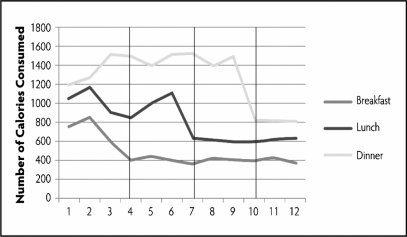Multiple Choice
Dr.Anderson is a nutritionist who helps clients lose weight prior to surgery.She is working with W.J. ,a male client who is planning on undergoing a heart transplant.He currently eats more than 3,500 calories a day and has been asked by his doctor to cut the number of calories to about 1,800 (400 for breakfast,600 for lunch,and 800 for dinner) .She is curious as to whether a food journal will help W.J.reduce the number of calories he eats.A food journal is used to record everything a person eats.Dr.Anderson decides to phase in the food journal gradually,initially only recording what is eaten at breakfast during the first three days after baseline (days 4-6) .During days 7-9,the journal is used at lunch,too,and during days 10-12,it also is used during dinner.Each day,Dr.Anderson's client sends her entries from the food journal and the number of calories he ate at each meal (as calculated by his wife,whose help she enlisted) .The data for Dr.Anderson's study are below.

-What type of small-N design has Dr.Anderson used with W.J.?
A) Interrupted time-series design
B) Stable-baseline design
C) Multiple-baseline design
D) Reversal design
Correct Answer:

Verified
Correct Answer:
Verified
Q7: A wait-list design is helpful in dealing
Q25: The fact that the researcher does not
Q27: <br>Dr.Anderson is a nutritionist who helps clients
Q28: <br>Dr.Fletcher is interested in whether joining a
Q30: <br>Dr.Fletcher is interested in whether joining a
Q31: <br>Dr.Fletcher is interested in understanding whether joining
Q34: <br>Dr.Anderson is a nutritionist who helps clients
Q44: Which of the following is a difference
Q55: Why do quasi-experiments tend to have very
Q60: In which of the following ways are